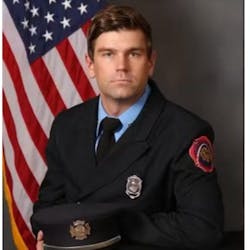On Jan. 13, 2022, St. Louis Firefighter Benjamin Polson answered his final alarm.
He was killed in a collapse while conducting a search during a fire in an abandoned, derelict house.
Following a probe that involved interviews with firefighters who were at the scene, NIOSH investigators determined a number of factors contributed to the fatal incident.
Among the issues cited include:
- Personnel staffing
- Professional development for acting fire officers
- Speed of the incident development, and the resulting impact on critical factors that are part of a risk/benefit analysis
- Derelict high-risk structure, susceptible to rapid fire spread and structural collapse
- Situational awareness at the task, tactical, and strategic levels
- Incident management, including risk assessment and management
- Mayday operations
- Communication equipment and procedures.
Investigators determined that Polson and another firefighter assigned to the truck had extinguished a fire on the first floor and proceeded to the second to check for possible victims.
Firefighters on an engine "who were not aware that members of T-13 had entered the
original fire building, then noticed a 1¾" hoseline from T-13 going into the front door of the original fire building. They decided that they would use that hoseline for the Side Delta exposure as they did not see any point of it being used on the original fire building given the significant volume of fire and the operations towards it would be defensive, investigators wrote.
Polson was trapped when the area above the second floor collapsed while the other firefighter was pushed back down the stairs to the landing between the two floors.
Dispatchers reported hearing an open mic from Polson's portable radio with no response.
His fellow firefighter met crews at the front door and told them what happened.
A captain immediately transmitted "E-24A, firefighter trapped inside the building, give me a second alarm with the second squad.”
About 45 minutes later, firefighters found Polson's body.
NIOSH issued recommendations:
- Ensure formal written guidance and leadership oversight is available and utilized for personnel staffing
- Develop and utilize a professional development program for acting fire officers that includes competency verification at the appropriate level(s) of responsibility
- When completing a risk/benefit analysis, evaluate the speed at which an incident is developing and how the speed may impact critical incident factors
- Develop and implement a High-Risk Building Management Program (HRBMP)
- Develop and utilize a professional development program for situational awareness and ensure that effective situational awareness is utilized at all emergency incidents
- Utilize formal guidance for incident management which incorporates risk assessment and management principles
- Consistently utilize formal guidance for calling, responding to, and managing a Mayday
- Take necessary actions to address the five critical elements for effective fireground
communications: professional development, necessary equipment, ability to function in varying environments, written guidance, and effective leadership at all levels.
About the Author
Susan Nicol
News Editor
Susan Nicol is the news editor for Firehouse.com. She is a life member and active with the Brunswick Volunteer Ambulance & Rescue Company, Oxford Fire Company and Brunswick Vol. Fire Co. Susie has been an EMT in Maryland since 1976. Susie is vice-president of the Frederick County Fire/Rescue Museum. She is on the executive committee of Frederick County Volunteer Fire and Rescue Association. She also is part of the Maryland Institute for Emergency Medical Services Systems (MIEMSS) Region II EMS Council. Susie is a board member of the American Trauma Society, Maryland Division. Prior to joining the Firehouse team, she was a staff writer for The Frederick News-Post, covering fire, law enforcement, court and legislative issues.

